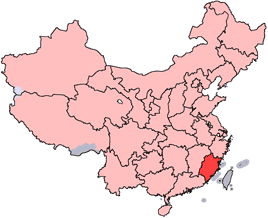Baimudan tea facts for kids
 |
|
| Type: | White |
|
|
|
| Other names: | Mudan White tea Mutan White tea White Peony tea Pai Mu Tan |
| Origin: | Fujian Province, China |
|
|
|
| Quick description: | A fruity tea, similar to Yinzhen but fuller in body and more floral in aroma, yet not as astringent as Shou Mei. |
|
|
|

Baimudan tea is grown in Fujian province, China
|
Bai Mudan (which means white peony in Chinese) is a special kind of white tea. It comes from the Camellia sinensis plant. This tea is made from one young leaf bud and two fresh leaves. This is often called the "one bud, two leaf" method.
Many people who enjoy white tea prefer Bai Mudan. They like its rich flavor and stronger taste. Another main type of white tea, Bai Hao Yinzhen, is made only from leaf buds. This makes Bai Hao Yinzhen taste softer and more gentle. The unique flavor of Bai Mudan comes from how it is made and the specific tea plants used.
Contents
How Bai Mudan Tea is Made
Special Tea Plants for White Peony
The tea plants used to make Bai Mudan are called "Dai Bai" varieties. In eastern Fujian Province, a plant called Fuding Dai Bai is used. In northern Fujian, they use the Zhenghe Dai Bai plant. These different plants create two unique styles of Bai Mudan tea. They are known as the Fuding variety and the Zhenghe variety.
The Gentle Process of Making White Tea
True Bai Mudan is a white tea. This means it is only slightly oxidized. Oxidation is a natural process where enzymes in the tea leaves react with air. This reaction helps create the tea's final taste and smell.
First, the freshly picked tea leaves are left in the sun to wilt. This can take from one to three days, depending on the weather. After wilting, the leaves are gently piled up for a short time. This piling allows a little bit of oxidation to happen. This step usually lasts between 30 minutes and three hours.
Next, the leaves are baked to dry them completely. This prepares them for packaging. The tea makers handle the leaves very carefully throughout the whole process. They do this to avoid breaking the leaf cells. If the cells break, the leaves oxidize too quickly, which can harm the tea's quality.
Even though making white tea seems simple, it takes a long time. Many things, like the weather, can affect the process. For example, a sudden rainstorm during the wilting stage can ruin the leaves. This makes the production of Bai Mudan quite challenging and costly.
Enjoying and Brewing Bai Mudan Tea
What Bai Mudan Tea Tastes Like
When you brew Bai Mudan tea, you might notice a soft peony scent. It also has a lovely floral smell. The tea itself has a fruity flavor. It tastes stronger than Silver Needle tea but not as strong as Shou Mei tea.
The best Bai Mudan tea has a clear, shimmering color when brewed. It has a delicate, lasting smell. The taste is fresh, smooth, and sweet. It should not taste bitter or like grass.
How to Brew Your Tea
To get the best flavor, it's good to brew Bai Mudan tea with clean mineral water. The water temperature should be between 70 °C and 80 °C (158 °F to 176 °F). When brewed, the tea will have a very pale green or golden color.
Types of Bai Mudan Tea
- Gushan Baiyun is also known as Drum Mountain White Cloud. This is a very good quality Bai Mudan tea. It was first grown by Buddhist monks. They grew it at a monastery on Drum Mountain in the Fujian Province. This tea has a nutty smell. A famous explorer named Robert Fortune reportedly tasted this tea during his travels in China.
See also
 In Spanish: Bai mu dan para niños
In Spanish: Bai mu dan para niños


